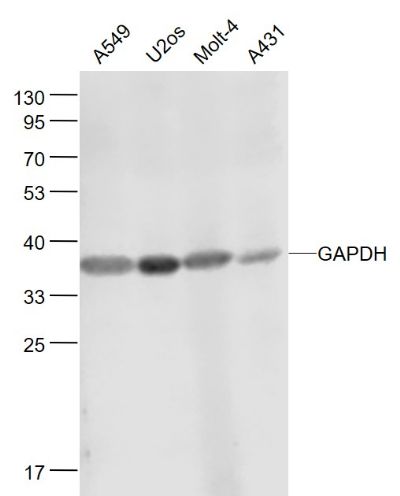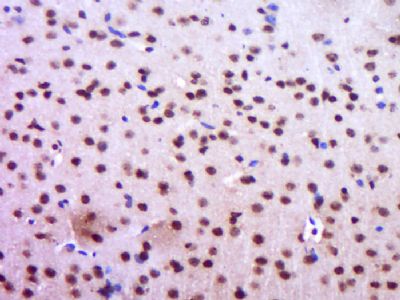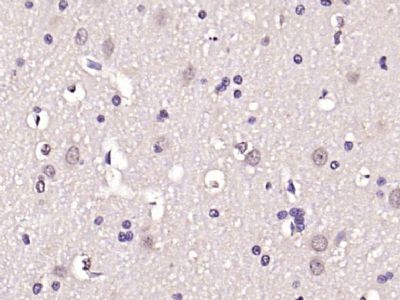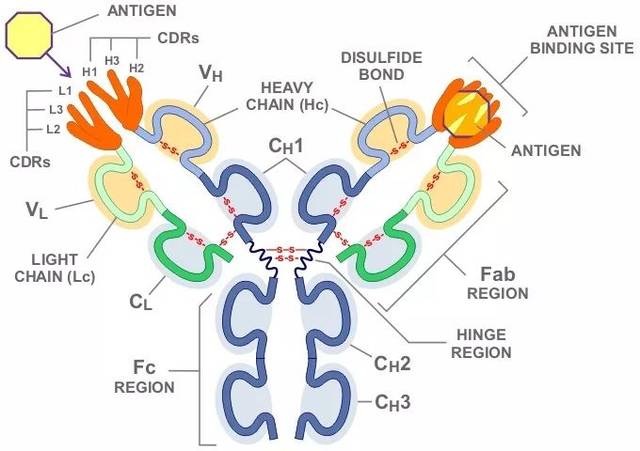Product Name :
GAPDH (Loading Control) polyclonal antibody Background :
Glyceraldehyde 3 phosphate dehydrogenase (GAPDH) is well known as one of the key enzymes involved in glycolysis. As well as functioning as a glycolytic enzyme in cytoplasm, recent evidence suggests that mammalian GAPDH is also involved in a great number of intracellular proceses such as membrane fusion, microtubule bundling, phosphotransferase activity, nuclear RNA export, DNA replication, and DNA repair. During the last decade a lot of data appeared concerning the role of GAPDH in different pathologies including prostate cancer progression, programmed neuronal cell death, age related neuronal diseases, such as Alzheimer's and Huntington's disease. GAPDH is expressed in all cells. It is constitutively expressed in almost all tissues at high levels. There are however some physiological factors such as hypoxia and diabetes that increase GAPDH expression in certain cell types. GAPDH molecule is composed of four 38kDa subunits. Product :
0.01M TBS(pH7.4) with 1% BSA, 0.03% Proclin300 and 50% Glycerol. Storage&Stability :
Store at 4°C short term. Aliquot and store at -20°C long term. Avoid freeze-thaw cycles. Specificity :
GAPDH (Loading Control) polyclonal Antibody detects endogenous levels ofGAPDH (Loading Control) protein. Immunogen :
GAPDH protein of rabbit: Conjugate :
Unconjugated Modification :
Unmodification
GAPDH (Loading Control) polyclonal antibody Background :
Glyceraldehyde 3 phosphate dehydrogenase (GAPDH) is well known as one of the key enzymes involved in glycolysis. As well as functioning as a glycolytic enzyme in cytoplasm, recent evidence suggests that mammalian GAPDH is also involved in a great number of intracellular proceses such as membrane fusion, microtubule bundling, phosphotransferase activity, nuclear RNA export, DNA replication, and DNA repair. During the last decade a lot of data appeared concerning the role of GAPDH in different pathologies including prostate cancer progression, programmed neuronal cell death, age related neuronal diseases, such as Alzheimer's and Huntington's disease. GAPDH is expressed in all cells. It is constitutively expressed in almost all tissues at high levels. There are however some physiological factors such as hypoxia and diabetes that increase GAPDH expression in certain cell types. GAPDH molecule is composed of four 38kDa subunits. Product :
0.01M TBS(pH7.4) with 1% BSA, 0.03% Proclin300 and 50% Glycerol. Storage&Stability :
Store at 4°C short term. Aliquot and store at -20°C long term. Avoid freeze-thaw cycles. Specificity :
GAPDH (Loading Control) polyclonal Antibody detects endogenous levels ofGAPDH (Loading Control) protein. Immunogen :
GAPDH protein of rabbit: Conjugate :
Unconjugated Modification :
Unmodification
-
 Anti- GAPDH at 1/300 dilution
Anti- GAPDH at 1/300 dilution -
 Anti-GAPDH at 1/2000 dilution
Anti-GAPDH at 1/2000 dilution -
 Anti-GAPDH at 1/2000 dilution
Anti-GAPDH at 1/2000 dilution -
 Anti-GAPDH at 1/2000 dilution
Anti-GAPDH at 1/2000 dilution
Elevated prohibitin 1 expression mitigates glucose metabolism defects in granulosa cells of infertile patients with endometriosis
PMCID: Pubmed No.:35639746
Effect of Secreted Frizzled-Related Protein 5 in Mice with Heart Failure
PMCID: Pubmed No.:35685732
Molecular mechanism of the ESRRG-PERM1-CKMT2 signal axis in ovariectomized female rats with OSAHS
PMCID: Pubmed No.:35623593
miR-146a-5p promotes epithelium regeneration against LPS-induced inflammatory injury via targeting TAB1/TAK1/NF-κB signaling pathway
PMCID: Pubmed No.:36096257
Hippocampus-prefrontal cortex inputs modulate spatial learning and memory in a mouse model of sepsis induced by cecal ligation puncture
PMCID: Pubmed No.:36377471
Curcumin combined with arsenic trioxide in the treatment of acute myeloid leukemia: network pharmacology analysis and experimental validation
PMCID: Pubmed No.:36352148
Fluoride-Induced Cortical Toxicity in Rats: the Role of Excessive Endoplasmic Reticulum Stress and Its Mediated Defective Autophagy
PMCID: Pubmed No.:36327065
Soluble E-cadherin promotes invasiveness of neoplastic cells in salivary gland carcinoma ex pleomorphic adenoma
PMCID: Pubmed No.:36445289
NRG1 knockdown rescues PV interneuron GABAergic maturation deficits and schizophrenia behaviors in fetal growth restriction mice
PMCID: Pubmed No.:36460658
Up-Regulation of SH3TC2 Induced by YTHDF1 Predicts Poor Outcome and Facilitates Cell-Cycle Progress in Colorectal Cancer
PMCID: Pubmed No.:36568637
Flot2 acts as a novel mediator of podocyte injury in proteinuric kidney disease
PMCID: Pubmed No.:36632460
CaMKII may regulate renal tubular epithelial cell apoptosis through YAP/NFAT2 in acute kidney injury mice
PMCID: Pubmed No.:36718671
A modified apical resection model with high accuracy and reproducibility in neonatal mouse and rat hearts
PMCID: Pubmed No.:36806296
Identification of a novel small-molecule inhibitor of miR-29b attenuates muscle atrophy
PMCID: Pubmed No.:36891498
Serum exosomes from epithelial ovarian cancer patients contain LRP1, which promotes the migration of epithelial ovarian cancer cell
PMCID: Pubmed No.:36842607
Increased level of exosomal miR-20b-5p derived from hypothermia-treated microglia promotes neurite outgrowth and synapse recovery after traumatic brain injury
PMCID: Pubmed No.:36804284
Macrophage-derived GPNMB trapped by fibrotic extracellular matrix promotes pulmonary fibrosis
PMCID: Pubmed No.:36732560
Skeletal Muscle-Derived Exosomal miR-146a-5p Inhibits Adipogenesis by Mediating Muscle-Fat Axis and Targeting GDF5-PPARγ Signaling
PMCID: Pubmed No.:36901991
Cytoplasmic localization of IRF5 induces Wnt5a/E-cadherin degradation and promotes gastric cancer cells metastasis
PMCID: Pubmed No.:36782048
DIFFERENTIATED EMBRYONIC CHONDROCYTE EXPRESSED GENE-1 IS A CENTRAL SIGNALING COMPONENT IN THE DEVELOPMENT OF COLLAGEN-INDUCED RHEUMATOID ARTHRITIS
PMCID: Pubmed No.:36739947
DIFFERENTIATED EMBRYONIC CHONDROCYTE EXPRESSED GENE-1 IS A CENTRAL SIGNALING COMPONENT IN THE DEVELOPMENT OF COLLAGEN-INDUCED RHEUMATOID ARTHRITIS
PMCID: Pubmed No.:36739947
DIFFERENTIATED EMBRYONIC CHONDROCYTE EXPRESSED GENE-1 IS A CENTRAL SIGNALING COMPONENT IN THE DEVELOPMENT OF COLLAGEN-INDUCED RHEUMATOID ARTHRITIS
PMCID: Pubmed No.:36739947
Overcoming ABCB1-mediated multidrug resistance by transcription factor BHLHE40
PMCID: Pubmed No.:36931039
Anti-inflammatory and immunomodulatory effects of polysaccharide extracted from Wuguchong (maggot) on 2,4-dinitrochlorobenzene-induced atopic dermatitis in mice.
PMCID: Pubmed No.:37033625
IBV QX affects the antigen presentation function of BMDCs through non-structural protein16
PMCID: Pubmed No.:36972672
A potential link between fibroblast growth factor-23 and the progression of AKI to CKD
PMCID: Pubmed No.:37016338
MiR-431 attenuates synaptic plasticity and memory deficits in APPswe/PS1dE9 mice
PMCID: Pubmed No.:37192007
FLOT1, stabilized by WTAP/IGF2BP2 mediated N6-methyladenosine modification, predicts poor prognosis and promotes growth and invasion in gliomas
PMCID: Pubmed No.:37260902
Dysregulation of MiR-199a/IL8 pathway in chronic Cr (VI)-induced tumor growth and angiogenesis
PMCID: Pubmed No.:37343486
Function and regulation of nuclear factor 1 X-type on chondrocyte proliferation and differentiation
PMCID: Pubmed No.:37433356
Synergistic anti-tumour activity of ginsenoside Rg3 and doxorubicin on proliferation, metastasis and angiogenesis in osteosarcoma by modulating mTOR/HIF-1α/VEGF and EMT signalling pathways
PMCID: Pubmed No.:37498992
Early-life noise exposure causes cognitive impairment in a sex-dependent manner by disrupting homeostasis of the microbiota–gut–brain axis
PMCID: Pubmed No.:37648006
Blueberry extracts antagonize Aβ25–35 neurotoxicity and exert a neuroprotective effect through MEK-ERK-BDNF/UCH-L1 signaling pathway in rat and mouse hippocampus
PMCID: Pubmed No.:37647279
Paternal methamphetamine exposure induces higher sensitivity to methamphetamine in male offspring through driving ADRB1 on CaMKII-positive neurons in mPFC
PMCID: Pubmed No.:37857642
Impaired neural circuitry of hippocampus in Pax2 nervous system-specific knockout mice leads to restricted repetitive behaviors
PMCID: Pubmed No.:37786962
Bioworld Biotech only provide peptides for our antibodies and do not provide additional peptide customization services.
Price/Size :
USD 368/1mg/vial
Tips:
For phospho antibody, we provide phospho peptide(0.5mg) and non-phospho peptide(0.5mg).Describe :
Blocking peptides are peptides that bind specifically to the target antibody and block antibody binding. These peptide usually contains the epitope recognized by the antibody. Antibodies bound to the blocking peptide no longer bind to the epitope on the target protein. This mechanism is useful when non-specific binding is an issue, for example, in Western blotting (WB) and Immunohistochemistry (IHC). By comparing the staining from the blocked antibody versus the antibody alone, one can see which staining is specific; Specific binding will be absent from the western blot or IHC performed with the neutralized antibody.Formula:
Synthetic peptide was lyophilized with 100% acetonitrile and is supplied as a powder. Reconstitute with 0.1 ml DI water for a final concentration of 10 mg/ml.The purity is >90%,tested by HPLC and MS.
Storage:
The freeze-dried powder is more stable. For short time at 2-8°C. For long term storage store at -20°C.
Note :
This product is for research use only (RUO only). Not for use in diagnostic or therapeutic procedures.
 GAPDH (Loading Control) polyclonal antibody
GAPDH (Loading Control) polyclonal antibody  Datasheet
Datasheet COA
COA MSDS
MSDS SHIP
SHIP